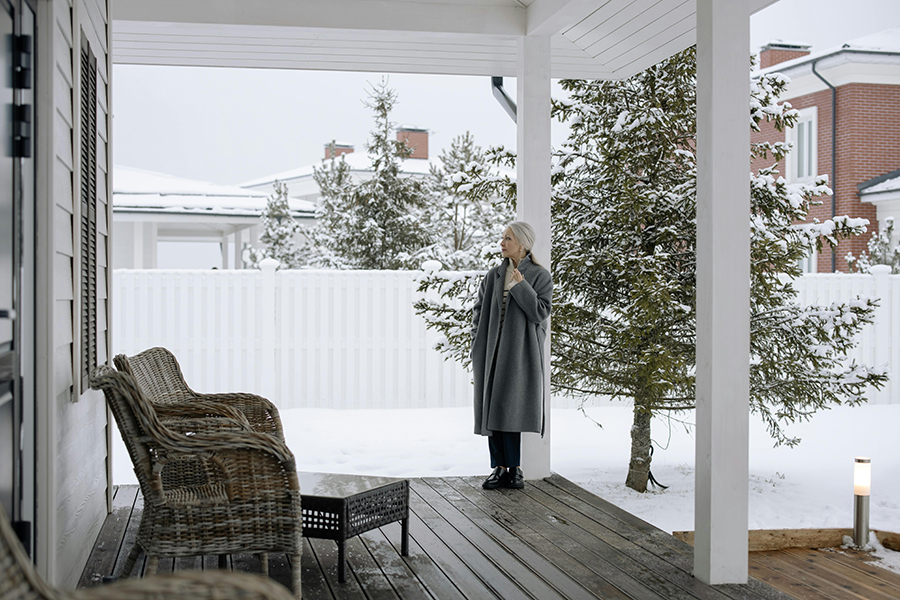With cold weather on the way for many, let’s look at how you can best prepare your home.

Being prepared for winter doesn’t have to be complex or overwhelming. By making a few changes or safety additions to your home, you can feel confident and ready for the chilliest weather this winter. In this blog, we’ll take a look at a few tips for winter preparation for your home, whether you live in a senior living facility, apartment, or house. Let’s dive in.
Create a Safety Bin
Having a stash of emergency supplies in the unlikely event of an emergency can give you peace of mind. Consider using a small storage bin or tote to hold all of your essential items in one place. Common things to include in your box are flashlights and batteries, bottled water, candles, emergency communication cards, a first aid kit, and any other applicable emergency supplies. Having all of your supplies in one spot makes retrieving them easy and stress-free, especially if you’re in the dark.
Have Extra Food and Snacks
Prepping for winter weather can include stocking up on some of your favorite shelf-stable meals or snacks. Granola, nuts, dried fruit, cereals, crackers, or chips are all shelf-stable and will provide snacks during power outages. Plus, having a few extra items in the kitchen can help with unexpected snowstorms when getting to the store may be difficult for a few days. Keep an eye on the weather, and if snow or ice seems to be on its way, try stocking up with additional provisions.
Add Insulation Around Doors or Windows
Adding extra insulation around doors or windows is a great way to winterize your home. Consider using specialized door blockers or matting to secure doors or windows to keep warm air inside and cool air out. Whether you have a drafty front door, chilly hallway, or want to keep part of your home warmer than others, these mats can help reduce the transfer of colder air into your living space. In the coldest days, especially if you live in an area where temperatures can drop dangerously low, consider placing towels or blankets across drafty windows or sliding glass doors. Be mindful of safety when doing this, and keep emergency exits free and clear.
Drains, Pipes, and Water Hoses
When properly winterizing your home, it’s important to be mindful of water. When water freezes, it expands, and this can lead to burst pipes and water where it is not wanted. If you’re in a home, be sure to drain your pipes and water spigots or hoses before the first freeze to ensure you’re ready for the coldest weather. And, if you will be away from your home for an extended time, make sure to leave the heat on (even if at a slightly lower temperature) to ensure pipes won’t freeze while you are gone.
Be Prepared with Medications and Essential Devices
When preparing for winter, try to have a stash of essential medications, batteries for any medical devices like hearing aids, and spare battery power banks to recharge items in case of a power outage. Having extras of the essentials can give you peace of mind, even in case of poor weather or emergency situations. Be sure to regularly recharge these power banks and devices so that you’re ready with a full charge for any outage.
Invest in Extra Layers
For chilly evenings, invest in thick, warm blankets in natural fibers like wool or alpaca, or try a heated blanket. These can keep you toasty during most winter evenings, but can be invaluable during a power outage to keep you and others in your home warm and safe. Natural fibers are excellent at keeping in heat, so consider investing in a wool sweater or mittens as well.
Have a Plan For Snow
If you live in a house, having a plan for snow removal is key. Will you have a neighbor, service, or family help with snow removal? Will you use salt or sand? Will you remove it yourself or operate a snow blower? Having a plan in place before the first snowfall of the year can give peace of mind and make you feel prepared for the winter to come. Be mindful of noise exposure with winter tools!
If you live in an apartment or senior living facility, be mindful of what their snow removal process looks like. You can always ask your facility manager or supervisor about the timeframe of removal and any preventative measures, like salt or sand, your complex will take for safety.
Do a Safety Walkthrough of Your Home
One winter preparedness activity you may not think to do is a quick safety walkthrough of your own home. You may want to invite a close friend or family member over to help take note of things you’re used to seeing. Keep an eye out for pipes that are close to exterior walls that may get frozen, portable heaters that are too close to furniture or flammable items, drafty windows or doors that need to be sealed or repaired, or outside spots that can get icy or slippery. You may also want to take note of any trees close to powerline or that are leaning; they may be a candidate for trimming or removal. You can take notes as a reminder, or make fixes along your walkthrough.
Getting prepared for winter means keeping an eye on warmth, safety, and preparedness in your home. Creating a stockpile of batteries, food, and emergency supplies is a great idea for anyone living in a cold climate, and taking time to winterize your home can help you feel prepared and confident for even the coldest weather no matter where you’re living. For more helpful tips, visit the CapTel blog.


